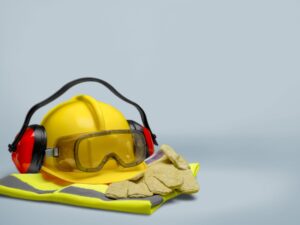
Managing Dust in Industrial Environments: Best Practices for Minimising Airborne Particles
Dust in industrial workplaces is more than just a cleaning problem—it can harm indoor air quality and put employees’ health at risk. Controlling dust is essential for a safe, productive, and compliant workplace.
This article covers the health risks of airborne dust, the importance of dust control, and practical strategies to reduce dust in industrial environments.
Health Risks of Dust in the Workplace
In small amounts, dust may seem harmless, but in industrial settings, large amounts of dust can build up and circulate in the air. Fine particles from materials like wood, metal, or chemicals can become airborne and easily inhaled.
Long-term exposure to these particles can lead to breathing problems, skin irritation, and, in serious cases, chronic lung issues like silicosis or asthma.
The risks associated with dust in the workplace include:
- Breathing Issues: Inhaling fine dust particles can lead to lung inflammation, irritation, and respiratory diseases. Chronic exposure to silica or asbestos dust, for example, can lead to lung damage.
- Skin & Eye Irritation: Dust particles can settle on exposed skin or in the eyes, causing irritation, rashes, or even infection over time.
- Fire & Explosion Hazards: Some dust types, like those from wood or certain metals, are combustible. Collections of these particles can increase the risk of fires or explosions if they meet an ignition source.
Effective dust management helps businesses protect employee health and safety while minimising compliance risks and potential liabilities.
Why Dust Control Matters in Industrial Settings
Controlling dust isn’t just about health; it’s also key for smooth operations and compliance. High dust levels can clog and damage machinery, leading to costly downtime and repairs.
A clean work environment also boosts employee morale, showing a commitment to their well-being. Industrial dust control is essential for:
- Employee Health: Reducing dust exposure minimises health risks and improves overall worker safety.
- Operations Efficiency: Clean equipment operates more efficiently, reducing maintenance costs and extending equipment life.
- Regulatory Compliance: Adhering to air quality standards helps companies avoid penalties and demonstrates compliance with health and safety regulations.
Best Practices for Managing Dust in Industrial Environments
Managing dust effectively requires a proactive approach that includes strong ventilation and regular cleaning. Here are some key practices to control dust in industrial settings.
Use Effective Ventilation Systems
Ventilation is essential for keeping dust levels low. Installing local exhaust ventilation (LEV) systems at dust sources, like areas where grinding, sanding, or cutting occurs, can capture particles before they spread. LEVs are especially effective when dust production is constant.
In addition, general ventilation systems, like HVACs, should be regularly inspected and maintained to keep them running well. Properly working ventilation systems help clear dust from the air, preventing it from settling on surfaces or being inhaled by employees.
Set Up Regular Cleaning Protocols
Regular cleaning helps prevent dust buildup on surfaces, floors, and equipment. HEPA-filter vacuums are usually more effective than sweeping because they trap fine particles instead of releasing them into the air. Wet-wiping surfaces also captures dust particles, making them easier to remove.
To stay on top of dust, set up daily or weekly cleaning schedules based on dust type and production volume. Also, using closed containers for waste and storage can limit dust spread across the facility.
Provide Personal Protective Equipment (PPE)
In high-dust areas, PPE is vital for employee safety. Masks or respirators with filters protect workers from inhaling dust, while gloves and protective eyewear help prevent skin and eye irritation.
Training employees on PPE use is equally important. This ensures they know how to protect themselves and understand the health risks of dust exposure.
Implement Air Monitoring & Dust Assessment Services
Regular air quality monitoring is essential for tracking dust levels and pinpointing problem areas within the workplace. Dust assessments, like those provided by Apex Environmental, can be customized to meet the specific needs of various industries. These assessments identify sources of airborne dust and monitor changes over time.
By analysing this data, companies can make targeted improvements to ventilation, adjust cleaning routines, or relocate equipment to better manage dust levels. Apex Environmental’s approach combines qualitative and quantitative methods, providing a thorough understanding of dust movement and concentration within the facility.
By adhering to standards such as the Regulations for Hazardous Chemical Agents, Apex Environmental helps businesses maintain compliance and create a safer workplace with clean air.
Maintain Equipment & Dust Collection Systems
Regular maintenance of machinery and dust-producing equipment is crucial for reducing dust output. Dust collectors and air filters should be emptied and cleaned as per manufacturer recommendations to keep them functioning at their best.
Routine equipment inspections catch potential issues early, prevent excessive dust collection, and contribute to a cleaner, healthier facility overall.
Establish Dust-Control Policies & Train Employees
An effective dust-control program should include clear policies and regular training sessions to help employees understand their role in maintaining a dust-free environment. Training can cover everything from proper cleaning techniques to the correct use of PPE and recognizing signs of dust-related health risks.
By involving employees in dust control efforts, companies foster a culture of shared responsibility, where everyone contributes to maintaining a clean and safe workspace.
Conclusion: The Value of Proactive Dust Management
Dust in industrial environments poses significant health and safety risks, from breathing issues to fire hazards. Proactive dust management through effective ventilation, regular cleaning, and routine monitoring can greatly reduce these risks, creating a safer and more productive workplace.
With the right strategies, industrial facilities can keep indoor air quality good. This helps create a healthier and safer work environment for everyone.








